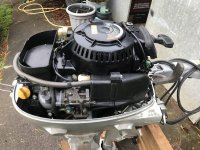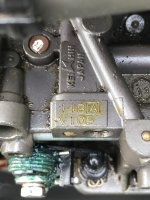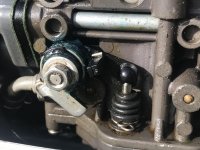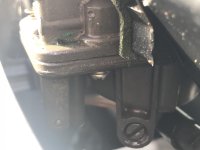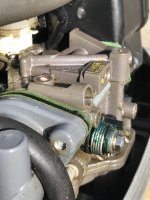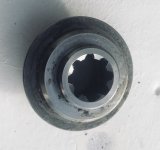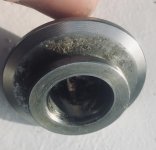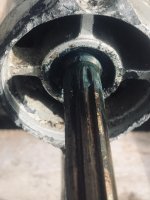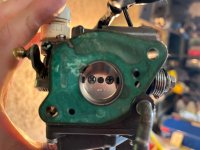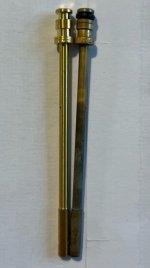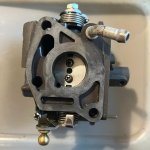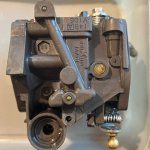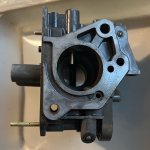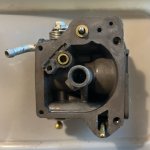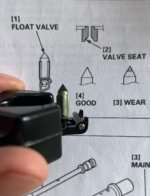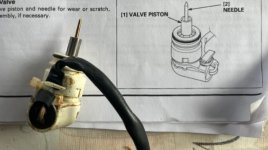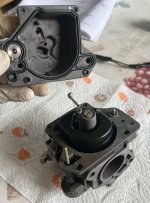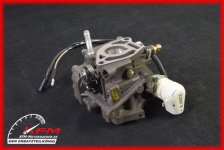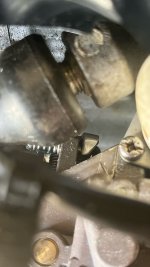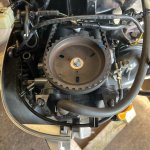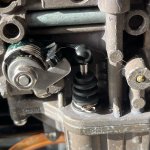Hi All;
I am in Europe (Ireland) and I have got a second-hand 2007 BF10D for a sailboat. This would be exactly the same as the 9.9 in the States - well, that is what I thought!
VIN is BABJ-1306966
The other ID plate says it is 2007, BF10D (HNX0222G0)
This is a tiller steered, electric start (plus manual), automatic choke, long shaft version.
This engine was a little neglected (but running), so far I have done the usual - impeller, cleaned out the lower unit, gear oil, motor oil, new sparkplugs, new fuel line and bulb, restored coolant water flow due to blockages..
Compression is fine and she runs first pull (and via starter motor), but does not like to go above idle. Dies when I throttle up. Thermostat is fine (cleaned all that area out and tested it in boiling water) - but will replace anyway. But I don't think it's overheating, because using carb cleaner in the air intake while running got her revving up for a while. So I am guessing carb jets are blocked or maybe the gaskets are bad.
Cleaning the carb and replacing the gaskets is the obvious first step but I thought it would be better to replace the carb assembly entirely and clean the original, keeping it as a spare.
So, I go over to SVB24.de (a German chandlery) and they offer a replacement carb for 126€ - great deal I think.
The parts number for this carb assy is 16100-ZW9-G01.
Then I decide to double check the parts diagrams on the SVB site, and I notice they say that they are for the >2012 models.
https://www.svb24.com/en/spare-parts/spare-parts-for-outboards-honda-outboards-bf10.html
Most items are identical to previous models (motor design seems unchanged since 2003), but of course, not the carb.:rolleyes:
I can’t seem to find an EU/ROW parts finder database online. The official Honda parts site is US only - and doesn’t recognise my serial number!
So I go to the US ones, like boats.net. Here I find my VIN number (BABJ-1306966) corresponds to a 2004 BF9.9D4 LHSA model (well, without the “A” for “American” I presume). This is a bit funny as my engine is 2007. Nevertheless, the carb assy parts numbers are identical between the 2003-2007 models.
Nevertheless, the carb assy parts numbers are identical between the 2003-2007 models.
I come across this thread:
http://www.marineengine.com/boat-fo...9-Tiller-poor-running&highlight=16100-ZW9-716
Which confirms that manual/auto start need different carbs and won’t be compatible..
The correct carb for my model is 16100-ZW9-816 according to the parts diagram.
https://www.boats.net/catalog/honda...-babj-1300001-to-babj-1399999/carburetor-auto
Well of course this is more expensive than the >2012 one from Germany, but, ok. I shop around and see on Defender the same carb:
https://www.defender.com/product.jsp?id=1829803
Note, this says,
“Identification: Replacement for Carburetors Stamped BJ02BD
Please be sure to check your stamp before ordering”
Good idea!
So I check my carb and it is stamped:
14B(A) V105
???
The carb on SVB for the >2012 models is "BJ14A A" apparently, so also different.
I google image search various Honda BF10s but in all of them, the code on the carb is never legible - nor is it visible on product photos..
So the question is -
- What the hell is the right carb for my model and where can I find it??
I don’t want to order something from the US that ends up being the wrong part because of some obscure EPA/EU emissions regulations…
Hopefully someone here will have an idea, I am stumped!
I am in Europe (Ireland) and I have got a second-hand 2007 BF10D for a sailboat. This would be exactly the same as the 9.9 in the States - well, that is what I thought!
VIN is BABJ-1306966
The other ID plate says it is 2007, BF10D (HNX0222G0)
This is a tiller steered, electric start (plus manual), automatic choke, long shaft version.
This engine was a little neglected (but running), so far I have done the usual - impeller, cleaned out the lower unit, gear oil, motor oil, new sparkplugs, new fuel line and bulb, restored coolant water flow due to blockages..
Compression is fine and she runs first pull (and via starter motor), but does not like to go above idle. Dies when I throttle up. Thermostat is fine (cleaned all that area out and tested it in boiling water) - but will replace anyway. But I don't think it's overheating, because using carb cleaner in the air intake while running got her revving up for a while. So I am guessing carb jets are blocked or maybe the gaskets are bad.
Cleaning the carb and replacing the gaskets is the obvious first step but I thought it would be better to replace the carb assembly entirely and clean the original, keeping it as a spare.
So, I go over to SVB24.de (a German chandlery) and they offer a replacement carb for 126€ - great deal I think.
The parts number for this carb assy is 16100-ZW9-G01.
Then I decide to double check the parts diagrams on the SVB site, and I notice they say that they are for the >2012 models.
https://www.svb24.com/en/spare-parts/spare-parts-for-outboards-honda-outboards-bf10.html
Most items are identical to previous models (motor design seems unchanged since 2003), but of course, not the carb.:rolleyes:
I can’t seem to find an EU/ROW parts finder database online. The official Honda parts site is US only - and doesn’t recognise my serial number!
So I go to the US ones, like boats.net. Here I find my VIN number (BABJ-1306966) corresponds to a 2004 BF9.9D4 LHSA model (well, without the “A” for “American” I presume). This is a bit funny as my engine is 2007.
I come across this thread:
http://www.marineengine.com/boat-fo...9-Tiller-poor-running&highlight=16100-ZW9-716
Which confirms that manual/auto start need different carbs and won’t be compatible..
The correct carb for my model is 16100-ZW9-816 according to the parts diagram.
https://www.boats.net/catalog/honda...-babj-1300001-to-babj-1399999/carburetor-auto
Well of course this is more expensive than the >2012 one from Germany, but, ok. I shop around and see on Defender the same carb:
https://www.defender.com/product.jsp?id=1829803
Note, this says,
“Identification: Replacement for Carburetors Stamped BJ02BD
Please be sure to check your stamp before ordering”
Good idea!
So I check my carb and it is stamped:
14B(A) V105
???
The carb on SVB for the >2012 models is "BJ14A A" apparently, so also different.
I google image search various Honda BF10s but in all of them, the code on the carb is never legible - nor is it visible on product photos..
So the question is -
- What the hell is the right carb for my model and where can I find it??
I don’t want to order something from the US that ends up being the wrong part because of some obscure EPA/EU emissions regulations…
Hopefully someone here will have an idea, I am stumped!
Last edited:


